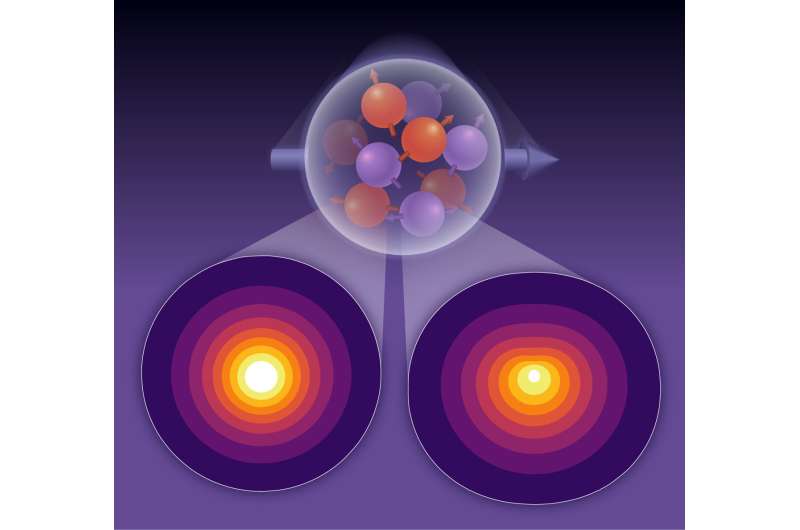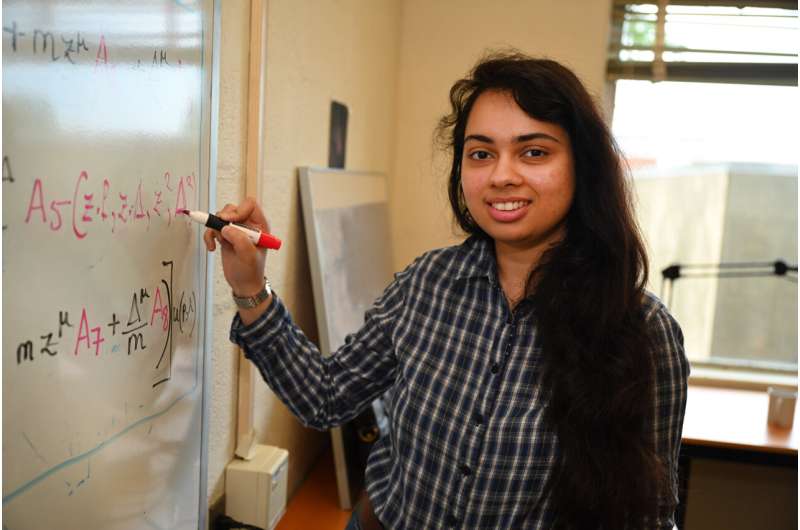This article has been reviewed according to Science X's editorial process and policies. Editors have highlighted the following attributes while ensuring the content's credibility:
fact-checked
peer-reviewed publication
trusted source
proofread
Calculations reveal high-resolution view of quarks inside protons

A collaboration of nuclear theorists at the U.S. Department of Energy's (DOE) Brookhaven National Laboratory, Argonne National Laboratory, Temple University, Adam Mickiewicz University of Poland, and the University of Bonn, Germany, has used supercomputers to predict the spatial distributions of charges, momentum, and other properties of "up" and "down" quarks within protons. The results, just published in Physical Review D, revealed key differences in the characteristics of the up and down quarks.
"This work is the first to leverage a new theoretical approach to obtain a high-resolution map of quarks within a proton," said Swagato Mukherjee of Brookhaven Lab's nuclear theory group and a co-author on the paper. "Our calculations show that the up quark is more symmetrically distributed and spread over a smaller distance than the down quark. These differences imply that up and down quarks may make different contributions to the fundamental properties and structure of the proton, including its internal energy and spin."
Co-author Martha Constantinou of Temple University noted, "Our calculations provide input for interpreting data from nuclear physics experiments exploring how quarks and the gluons that hold them together are distributed within the proton, giving rise to the proton's overall properties."
Such experiments are already taking place at the Continuous Electron Beam Accelerator Facility (CEBAF), a DOE Office of Science user facility at Thomas Jefferson National Accelerator Facility. Higher resolution versions are planned for the future Electron-Ion Collider (EIC) at Brookhaven Lab. In these experiments, high-energy electrons emit virtual particles of light that scatter off and change the overall momentum of a proton without breaking it apart.
The way the momentum of the proton changes in response to these scatterings reveals details about the quarks and gluons—the inner components of the proton—sort of like an X-ray imaging technique for the building blocks of bulk matter.
New theoretical approach to GPD
Specifically, the scatterings give scientists access to the Generalized Parton Distribution (GPD) of the proton—parton being the collective name for quarks and gluons. If you picture the proton as a bag filled with marbles representing quarks and gluons, the GPD provides a description of how the energy-momentum and other characteristics of these marbles are distributed within the bag—for example, when the bag is shaken and the marbles move around.
It can be compared to a map that indicates the likelihood of finding a marble with a specific energy-momentum at a particular position inside the bag. Knowing the distribution of these quark and gluon characteristics allows scientists to understand the inner workings of the proton, which may lead to new ways to apply that knowledge.
"To obtain a detailed map, we need to analyze many scattering interactions, involving various values of momentum change of the proton," said Shohini Bhattacharya, a research associate in Brookhaven's nuclear theory group and the RIKEN BNL Research Center (RBRC).
To simulate the multiple momentum changes of the proton efficiently, the researchers had to develop a novel theoretical approach, published recently in Physical Review D.
Previously, theorists used the idea that the proton's change in momentum was shared equally between the proton before the light scattered and afterward. This simplification provided a less accurate representation of reality and also made the simulations computationally expensive.
"Each momentum change value of the proton required a separate simulation, significantly increasing the computational burden to obtain a detailed proton map," Bhattacharya explained.
"The new method can look at the effect of the momentum transfer as all being on the outgoing proton—the final state. This gives a view that is closer to the actual physical process," she said.
"Most importantly, the new theoretical approach makes it possible to model numerous momentum transfer values within a single simulation."

Leveraging the lattice
The calculations describing quarks and their interactions are spelled out in a theory known as quantum chromodynamics (QCD). But because these equations have many variables, they are very difficult to solve. A technique known as lattice QCD, originally developed at Brookhaven Lab, helps to tackle the challenge.
In this method, physicists "place" the quarks on a discretized 4D spacetime lattice—a sort of 3D grid where quarks are at the nodes that accounts for how the arrangement of quarks changes over time (the fourth dimension). Supercomputers solve the equations of QCD by running through all the possible interactions of each quark with all the others, including how those interactions are affected by the myriad variables.
"The new formalism for modeling the interactions of photons (particles of light) with protons made it possible for us to leverage lattice QCD to simulate a much higher number of momentum transfers to achieve higher resolution imaging about 10 times faster than previous efforts," said study co-author Xiang Gao, a research associate at Argonne National Laboratory.
Because the equations of QCD have separate variables for up and down quarks, the method lets the scientists capture separate images of each quark type and calculate their individual GPDs.
Results and implications
In addition to mapping out the energy-momentum distributions of the up and down quarks, the team also mapped out their charge distributions within protons.
They also explored the quarks' momentum and charge distributions in polarized protons, where the protons' spins are aligned in a particular direction, to investigate how the inner building blocks contribute to the proton's spin. Proton spin is a property used every day in magnetic resonance imaging (MRI), allowing doctors to non-invasively see structures inside our bodies. But how this property arises from the proton's internal building blocks is still a mystery.
"Within a polarized proton, we found that the distribution of the momenta of the down quarks is particularly asymmetric and distorted compared to that of the up quarks," Gao said. "Since the spatial distribution of momentum tells us about the angular momentum of quarks inside a proton, these findings show that the different contributions of up and down quarks to the proton's spin arise from their different spatial distributions," he noted.
According to their calculations, the scientists concluded that up and down quarks can account for less than 70% of the proton's total spin. This implies that the gluons must contribute significantly as well. How the spin (angular momentum) of the proton is distributed among its constituent quarks and gluons provides clues about the proton's internal structure. This, in turn, helps scientists understand the forces that act within the atomic nucleus.
Experimental findings from Brookhaven Lab's Relativistic Heavy Ion Collider (RHIC), a DOE Office of Science user facility at Brookhaven Lab, support the idea of a significant gluon contribution to spin. This is one of the central questions that will be explored in great detail at the future EIC.
The new theoretical predictions will be used to provide essential information for comparison with those experiments, and to help scientists interpret their data, noted Joshua Miller, a co-author carrying out his Ph.D. research at Temple University under the supervision of Constantinou.
"These two complementary things—the theory and experiment—have to be combined to get the complete image of the proton," Miller said.
More information: Shohini Bhattacharya et al, Moments of proton GPDs from the OPE of nonlocal quark bilinears up to NNLO, Physical Review D (2023). DOI: 10.1103/PhysRevD.108.014507
Shohini Bhattacharya et al, Generalized parton distributions from lattice QCD with asymmetric momentum transfer: Unpolarized quarks, Physical Review D (2022). DOI: 10.1103/PhysRevD.106.114512
Journal information: Physical Review D
Provided by Brookhaven National Laboratory


















